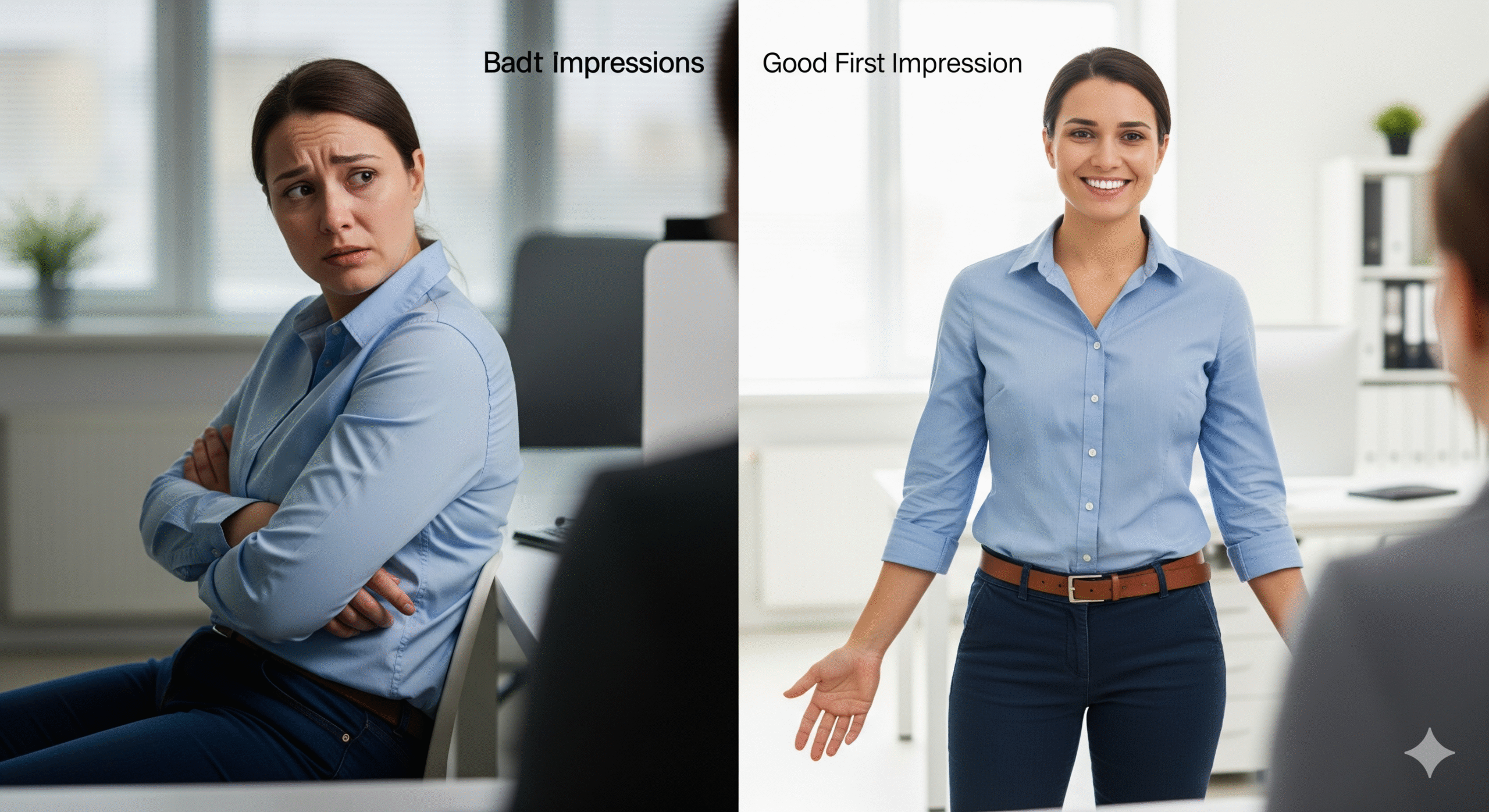Imagine walking into a room. In a flash—less time than it takes to blink—someone across the room has already formed a judgment about you. They’ve decided if you’re trustworthy, confident, intelligent, or approachable. They’ve processed your posture, your clothes, the set of your jaw, and the way you carry yourself. It might seem like magic, but it’s not. It’s a lightning-fast, deeply ingrained process rooted in psychology, neurology, and our evolutionary history.
We’ve all heard the adage: “You never get a second chance to make a first impression.” It’s a cliché because it’s true. The first impression we make, whether on a potential employer, a new friend, or a date, has a disproportionate and lasting impact on how we are perceived. But why are these initial judgments so powerful? What is the science that makes them stick?
This article will pull back the curtain on this fascinating phenomenon, exploring the psychological mechanisms that govern our snap judgments and providing a fact-based, practical guide to understanding and mastering the art of making a positive first impression.
The Background: Why Our Brains Love a Shortcut
The human brain is an efficiency machine. It’s wired to process vast amounts of information in an instant and make quick, on-the-fly decisions. This ability was a matter of survival for our ancestors—a split-second judgment about whether a stranger was friend or foe could be the difference between life and death. Today, while the stakes are rarely life-or-death, this ancient wiring remains a cornerstone of our social interactions.
The science behind this process is a concept known as “thin-slicing.” This term, popularized by author Malcolm Gladwell, refers to our ability to find patterns in events and behaviors based on a very brief, fleeting observation. Researchers have found that we can accurately judge a person’s intelligence, trustworthiness, or even sexual orientation from just a few moments of interaction. In fact, some studies show that we form a judgment about a stranger in as little as one-tenth of a second.
This rapid processing is made possible by our brain’s reliance on mental shortcuts, or heuristics. Two of the most important in the context of first impressions are:
- The Primacy Effect: This is the tendency to remember the first piece of information we encounter more vividly and accurately than information presented later. In a first impression, the initial information—your appearance, your opening line, your handshake—is given more weight than anything you say or do later. It becomes the lens through which all subsequent information about you is filtered.
- The Halo Effect: This is a cognitive bias where our overall impression of a person influences how we feel and think about their character or properties. If you see someone as attractive, for instance, you are more likely to also believe they are intelligent, kind, and successful, even if you have no evidence to support these beliefs. A single positive trait (the “halo”) can create a positive bias that colors all other judgments.
Together, thin-slicing, the primacy effect, and the halo effect create a powerful neurological cocktail that makes our initial judgments incredibly sticky and difficult to reverse.
A Comparison of Inputs: What Shapes That First Impression?
A first impression isn’t formed from a single input; it’s a symphony of sensory information processed in an instant. Think of it as a complex algorithm where every piece of data you provide—from the way you stand to the words you speak—is weighted and analyzed.
| Input Category | Key Elements | Psychological Impact |
| Visual Cues | Posture, Grooming, Attire, Facial Expressions, Eye Contact. | Forms the initial “threat or safety” assessment. A confident posture (straight shoulders, open stance) communicates power and control. A genuine smile signals warmth and trustworthiness. |
| Auditory Cues | Tone of Voice, Pitch, Speed, Clarity. | Conveys emotion and confidence. A warm, clear, and steady voice is often perceived as competent and reliable, while a high-pitched or nervous tone can signal anxiety. |
| Behavioral Cues | Handshake, Gestures, Punctuality. | Establishes professionalism and respect. A firm handshake (not a crushing one) and promptness demonstrate respect for the other person’s time and position. |
| Verbal Cues | Choice of Words, Vocabulary, Opening Line. | Provides context and intelligence. While often given less weight than non-verbal cues in the first few seconds, articulate and well-chosen words can quickly reinforce a positive visual impression. |
Export to Sheets
The most fascinating aspect of this breakdown is the hierarchy of influence. Research consistently shows that non-verbal communication—your body language, your posture, and the way you carry yourself—has a significantly greater impact on a first impression than the actual words you say. Your body speaks louder than your mouth.
Key Features of an Unforgettable First Impression
Understanding the science is one thing; applying it is another. By focusing on the core elements that contribute to a strong first impression, you can consciously take control of the narrative you present to the world.
1. Master Your Non-Verbal Communication
This is the single most important factor. Our brains are hardwired to trust what they see.
- The Power of Posture: Stand tall, with your shoulders back. A confident posture signals that you are comfortable in your own skin and competent in your role.
- The Genuineness of a Smile: A warm, authentic smile is universally disarming and signals that you are approachable and friendly.
- The Handshake: A firm, brief handshake communicates confidence and respect. A limp handshake, conversely, can signal a lack of confidence or disinterest.
2. The Art of the Spoken Word
While your body is doing the heavy lifting, your voice and words are there to reinforce the positive signals.
- Clarity and Confidence: Speak clearly and at a moderate pace. A nervous, rapid-fire delivery can undermine your credibility.
- Warmth in Your Tone: Your tone of voice can convey more than your words. Practice speaking with a warm, friendly tone that invites connection.
- Active Listening: A good first impression isn’t just about talking; it’s about listening. Show genuine interest by asking thoughtful questions and making eye contact.
3. The Power of Appearance
While we’re told not to judge a book by its cover, the science proves we do it anyway.
- Dress for the Occasion: Your attire should be appropriate for the context. It shows that you respect the setting and the people in it.
- Grooming and Hygiene: Taking care of your personal grooming signals self-respect and attention to detail.
The Double-Edged Sword: Pros and Cons of Our Snap Judgments
The fact that we rely so heavily on first impressions is a mixed bag. On one hand, it’s a brilliant, evolutionary tool. On the other, it can lead to significant biases and missed opportunities.
Pros:
- Speed and Efficiency: First impressions allow us to navigate complex social situations with incredible speed. In a world full of strangers, it’s a rapid-fire way to decide who to trust, who to avoid, and who to engage with.
- An Evolutionary Advantage: Historically, the ability to quickly assess a person’s intent was crucial for survival. This instinct is still at the heart of our social radar.
- A Foundation for Connection: A positive first impression can open doors and build a foundation for a lasting relationship, whether professional or personal.
Cons:
- Cognitive Bias and Stereotyping: The reliance on quick judgments can lead us to fall back on stereotypes. We may subconsciously judge a person based on their age, gender, race, or appearance, leading to unfair bias and discrimination.
- The Confirmation Bias Trap: Once a first impression is formed—especially a negative one—our brains are hardwired to look for information that confirms that initial judgment. This is the confirmation bias in action, and it makes it incredibly difficult to change a person’s mind.
- The Risk of Misjudgment: A person having a bad day, feeling nervous, or simply being an introvert can be misjudged as rude or uninterested. This can lead to a missed opportunity for a truly valuable connection.
Use Cases: Who Should Master the First Impression?
Understanding and mastering the science of first impressions isn’t just for a few select people; it’s a vital life skill. Here are just a few scenarios where it can make a tangible difference:
- The Job Seeker: A great first impression in a job interview can be the difference between getting hired and being passed over. Your confidence, eye contact, and prepared answers are all crucial.
- The Networker: In a crowded room full of strangers, your ability to quickly and positively engage with people is the key to building your professional network.
- The Public Speaker: An audience decides within the first few seconds if you are worth listening to. Your opening posture, smile, and confident demeanor set the stage for your entire presentation.
- The Salesperson: Building rapport with a client starts with that initial handshake and conversation. A positive first impression can build the trust necessary to close a deal.
- The Daters: Dating is essentially a series of first impressions. From your online profile to your first face-to-face meeting, the initial signals you send are pivotal to the relationship’s future.
FAQs: Your Questions About First Impressions Answered
How long does it actually take to form a first impression?
According to multiple psychological studies, it takes anywhere from one-tenth of a second to seven seconds. The brain makes initial judgments almost instantly, with the first few seconds of a meeting solidifying that initial perception.
Can you ever truly change a bad first impression?
It’s incredibly difficult but not impossible. The key is consistent, repeated positive behavior. The new, positive information must be so overwhelming and consistent that it forces the other person’s brain to override the initial negative perception. This takes time, patience, and unwavering effort.
What is the single most important factor in making a good first impression?
While many factors play a role, research consistently points to non-verbal cues—specifically body language, facial expressions, and eye contact—as the most influential. They are processed subconsciously and convey powerful information about confidence, trustworthiness, and warmth.
What role does appearance play in a first impression?
Appearance is a primary visual cue and a major factor. While it’s not about being the most attractive person, it is about presenting yourself in a way that is clean, well-groomed, and appropriate for the context. Your appearance signals self-respect and attention to detail, which our brains often translate into competence.
How does the internet impact first impressions?
The internet has changed the game by creating “pre-impressions.” Before meeting someone, people often have a chance to see your social media profiles, your LinkedIn, or your company bio. This digital footprint forms a powerful pre-conceived notion, making it all the more important to manage your online presence.
Conclusion: The Ultimate Social Superpower
The science of first impressions reveals a fundamental truth about human interaction: our brains are designed for speed, not accuracy. We are all quick to judge and slow to change our minds. This is both a blessing and a curse—a powerful tool for navigating the world, but also a source of unconscious bias.
Understanding this science is the first step toward gaining a valuable social superpower. It’s not about becoming someone you’re not; it’s about aligning your external presentation with your internal character. It’s about being aware of the signals you’re sending so you can make them work for you, not against you.
Final Verdict: The science proves that first impressions are not just a fleeting moment but a fundamental building block of our relationships. They are powerful, they are fast, and they are notoriously difficult to change. For anyone looking to improve their professional or personal life, there is no greater investment than understanding and intentionally shaping the first story you tell the world about yourself—the one that your body and your presence tell before you even say a word.







Leave a Reply